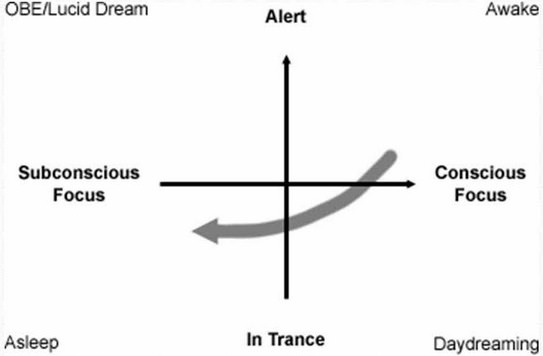Five New Sleep Commands toInduce Lucid Dreams
Today we'll cover five new sleep commands that you can use to quickly trick the body into falling asleep. This will enables you to end insomnia and have frequent lucid dreams and OBEs.
The Discovery of The Roll Over Signal and Sleep Paralysis Connection
I had been up all night working.
Around noon I was very tired and decided to lay down for a few moments. As I lay there I began to feel a very uncomfortable urge to roll over. For no real reason I decided to ignore it and just lay there. To my extreme surprise I felt the effect of sleep paralysis roll over me.
The paralysis was completely unexpected. I had always thought it was something you had to be very deeply relaxed to achieve. Instead I was actually fairly tense and my mind was not at all in any kind of meditative state.
I'd accidentally found something that I had never seen in any books on lucid dreaming: the "roll over signal" itself is all you need to enter paralysis.
I spent the next several months experimenting with different variations of what I'd done. I began looking for other ways to command the body into sleep and here's what I found.
The Two Types of Sleep Commands
It turns out sleep commands come in two types: sleep starters and sleep triggers.
- Sleep Starters are what you use to get the body to start thinking that maybe it's time to fall asleep. For instance, using Stop, Drop and Roll is a sleep starter because it makes your body ask for permission to fall asleep by artificially creating the roll signal.
- Sleep Triggers - Sleep triggers are how you then tell it "Yes: fall asleep right now". The example of Stop, Drop and Roll has an implicit sleep trigger: when you simply ignore the roll over signal the body interprets it a trigger to enter sleep paralysis.
Five New Sleep Commands
In this section we'll cover two sleep starters: sleep breathing and stopping eye micromovements.
Then we'll cover three sleep triggers: pause breaths, muscle twitching, and eye movements.
#1 - Sleep Breathing
Sleep breathing is simply mimicking your body's breathing pattern when it's asleep.
If you act closely enough like you're already asleep then your body thinks that it really is asleep, even if your mind is completely awake and not even slightly relaxed. There are three basic ways to find out what your personal sleep breathing is like.
- Sleep Paralysis Perspective - First, when you enter waking sleep paralysis a lot of times your perspective shifts slightly away from the center of your head and in to your sinuses. It sounds like you're breathing in a cavern and you'll find your body automatically breathes with quite a lot more force than you do when you're awake. The breathing is much deeper and longer. Pay attention to how this sounds in order to learn your sleep breathing pattern.
- Watch Waking Breathing - The second way to learn your sleep breathing pattern is to practice staying perfectly still when you wake up in the morning. You can continue to breathe the same way you did when asleep if you wake up gradually.
- Record Sleep Breathing - The third way, which is the best, is to record yourself sleeping. Get a digital voice recorder that can record the entire night. You can then use free software like Audacity to find the parts of the recording that have your sleep breathing. Once you have your recording you can listen to it right before you go to sleep in order to make sure you're on the right breathing rhythm.
When you use sleep breathing there are a three gotchas to be aware of:
- Sleep Breathing Learning Curve - The learning curve means that it takes practice and if you don't have the rhythm right it can prolong the time it takes to fall asleep. It's best to practice using sleep breathing for a couple nights before using it during an early morning OBE induction. However once you have the rhythm right, sleep breathing is probably the single most powerful of all the sleep commands. A while back I laid down in the afternoon and just starting doing sleep breathing. I didn't use any other methods at all and within 15 minutes I entered waking sleep paralysis. I could roll over and completely wreck the paralysis and then bring it back again with just 3 or 4 sleep breaths. I usually don't have that amount of control with sleep breathing, however it does show the potential power it has when you get the rhythm right.
- Blackout Breathing - A lot of times when you use sleep breathing for the first few minutes it seems like it's not working and you feel like you should give up. But then all of a sudden you black out and you're in a dream or you're waking up the next morning. The blackout breathing effect is very real so if you use sleep breathing for WILDs make sure you have a timer because otherwise there's a very good chance you'll send yourself so far into sleep so quickly that you'll never become lucid without a beep.
- Narcotic Breathing - Sometimes instead of blacking out all at once you get a relaxing feeling. It feels like when you first wake up in the morning and the last thing you want to do is get up out of bed. You just want to go back to sleep. This is very useful in destroying insomnia. When you get the narcotic breathing effect it feels really good to lay there and breathe and you'll have no desire to get up. Narcotic breathing is a signal that it's working and you'll be asleep very soon.
#2 - Stopping Eye Micromovements
The second sleep starter is to stop eye micromovements. During the day the eyes are searching for changes in motion. Because of this they make tiny eye micromovements all the time and at the end of they day they are still making these micromovements even though you may want to go to sleep.
If you close your eyes and try to keep them still you'll find that after about 30 seconds they are still twitching very slightly. It's not easy to totally relax the eyes. However if you can keep them at complete ease for several minutes the body will interpret that as a signal that the mind may have fallen asleep.
In fact if you keep your eyes still your body will often fall asleep even if the rest of your muscles are fairly tense.
Before sleep, relax your eye muscles by slowly rolling them around in wide circles in both directions several times and then letting them rest.
After 3 or 4 nights practicing this you'll be able to keep your eyes totally still and you'll fall asleep much faster.
This brings us to sleep triggers which are used to convert partial paralysis into full paralysis.

#3 - Pause Breaths
The first trigger is pause breaths. When you reach 90% paralysis, the reason the body doesn't go to full paralysis is it has a bit of doubt about just how asleep the mind really is. This is because of muscle tension. The best solution is to relax more deeply but sometimes that's not possible.
What you can do is exhale and pause for 2 or 3 seconds. Relax as much as you can and then begin breathing again like normal.
By relaxing your breathing you reduce your overall tension just barely enough to send a signal to complete the paralysis. During those 2 or 3 seconds you'll feel the paralysis deepening. Sometimes you may have to use 2 or 3 pause breaths about 15 seconds apart.
When you do this, you're not trying to alter your blood oxygen levels or anything like that. The purpose is to simply lower your overall muscle tension just long enough to paralyze completely.
#4 - Muscle Twitching
Muscle twitching was the first sleep trigger I ever discovered.
I reached partial paralysis and on a whim decided to try twitching my right forearm to see what happened. To my surprise my entire arm paralyzed. I then twitched my right calf and my right leg paralyzed. I gradually paralyzed my entire body that way and completed the separation.
In other words muscle twitching only paralyses the surrounding muscles. I've actually found that I could paralyze just a single finger by twitching it when in partial paralysis.
Do this twitch once every second or two when you're in about 95% paralysis. The twitch is very gentle and only lasts the smallest fraction of a second. If you twitch your forearm the rest of your arm should not move at all. If you twitch too hard you'll wreck the paralysis so keep it very light.
Probably the reason this works is when you dream you try to move your muscles but sleep paralysis prevents you from moving. However you do move your muscles just a bit when dreaming which causes muscle twitching. This means the body associates muscle twitching with deep sleep so one way to mimic deep sleep is to use muscle twitching.
#5 - Eye Movements
With your eyes closed, simply move your eyes up and down as fast as you can for about 10 seconds. I've never been able to get it to work using left and right movements.
However there is actually a type of hypnotic psychotherapy called "eye movement desensitization and reprocessing" or EMDR which uses side to side eye movements. You may try experimenting with side to side movement to complete partial paralysis but I find up and down is a safer bet.
The Order of Sleep Triggers
So which trigger do you use first?
The most reliable strategy is to start with a few pause breaths which is usually all it takes to get to 100% paralysis.
If that doesn't work use arm twitching. If that doesn't work use up and down eye movements.
If none of those work - just relax for a few more minutes before using the triggers again.
When to Use Sleep Triggers
I've experimented using sleep triggers to go directly from awake to asleep but that doesn't seem to work well.
I find that for up and down eye movements to work you need to be in about 99% paralysis, muscle twitching works at about 95% paralysis and pause breaths work at about 90% paralysis. So it's best to start out using sleep starters first and then switch to triggers to complete the process.
In the next lesson we'll cover the exact relaxation routine to fall asleep quickly to enter waking sleep paralysis.
 About The Guest Author
About The Guest Author
Nick Newport is the author of Lucidology, a website that teaches how to have lucid dreams and out of body experiences from a waking state.










